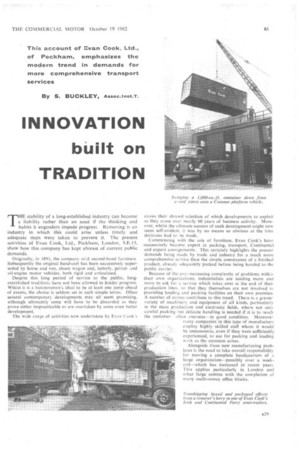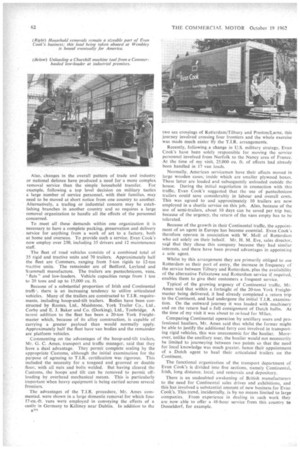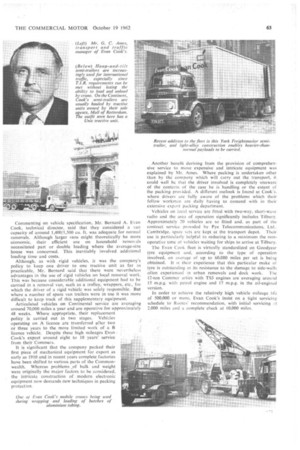INNOVATION built on TRADITION
Page 63

Page 64

Page 65

If you've noticed an error in this article please click here to report it so we can fix it.
By S. BUCKLEY, Associnst.T.
THE stability of a long-established industry can become a liability rather than an asset if the thinking and habits it engenders impede progress. Removing is an industry in which this could arise unless timely and adequate steps were taken to prevent it. The present activities of Evan Cook, Ltd., Peckham, London, S.E.15. show how this company has kept abreast of current public demands.
Originally, in 1893, the company sod second-hand furniture. Subsequently the original hand-cart has been successively superseded by horse and van, steam wagon and, latterly, petroland oil-engine motor vehicles, both rigid and articulated.
Despite this long period of service to the public, longestablished trad:tions have not been allowed to hinder progress. Whilst it is a businessman's ideal to be at least one jump ahead of events, the choice is seldom set in such simple terms. Often several contemporary developments may all seem promising, although ultimately some will have to be discarded as they prove either impracticable or are overtaken by some even better development The wide range of activities now undertaken by Evan Cook's shows their shrewd selection of which developments to exploit as they arose over nearly 60 years of business activity. Moreover, whilst the ultimate success Of such development might now seem self-evident, it was by no means so obvious at the lime decisions had to be made.
Commencing with the sale of furniture, Evan Cook's have successively become expert in packing, transport, Continental and export consignments. This certainly highlights the present demands being made by trade and industry for a much more comprehensive service than the simple conveyance of a finished product, already adequately packed before being handed to the public carrier.
Because of the ever-increasing complexity of problems within their own organizations, industrialists are tending more and more to ask for a service which takes over at the end of their production lines, so that they themselves are not involved in providing loading and packing facilities on their own premises. A number of causes contribute to this trend. There is a greater variety of machinery and equipment of all kinds, particularly in the mass production and electronic fields, where not only careful packing hut delicate handling is needed if it is to reach the customeroften overseas—in good condition. Moreover many companies In this type of manufacture employ highly skilled staff whom it would be uneconomic, even if they were sufficiently experienced, to use for packing and loading work as the occasion arises.
Alongside these new manufacturing problems is the need to take overall responsibility for moving a complete headquarters of a large organization—possibly over a weekend—which has increased in recent years. This applies particularly in London and other large centres with the completion of many multi-storey office blocks. Also, changes in the overall pattern of trade and industry or national defence have produced a need for a more complex removal service than the simple household transfer. For example, following a top level decision on military tactics a large number of service personnel, with their families, may need .to be moved at short notice from one country to another. Alternatively, a trading or industrial concern may be establishing branches in another country and so requires a large removal organization to handle all the effects of the personnel concerned.
To meet all these demands within one organization it is necessary to have a complete packing, preservation and delivery service for anything from a work of art to a factory, both at home and overseas. To provide such a service. Evan Cook's now employ over 250, including 35 drivers and 12 maintenance staff.
The fleet of road vehicles consists of a combined total of 35 rigid and tractive units and 70 trailers. Approximately half the fleet are Commers, ranging from 5-ton rigids to 12-ton tractive units. The remainder are of Bedford, Leyland and Scammell manufacture. The trailers are pantechnicons, vans. " flats " and low-loaders. Vehicle capacities range from I ton to 20 tons and up to 15,000 cu. ft.
Because of a substantial proportion of Irish and Continental traffi-. there is an increasing tendency to utilize articulated vehicles. Many of the trailers are constructed to T.I.R. requirements, including hoop-and-tilt trailers. Bodies have been constructed by Rootes, Ltd., Maidstone, York Trailer Co., Ltd., Corby and E. I. Baker and Co. (Dorking), Ltd., Tonbridge. A recent addition to the fleet has been a 20-ton York Freightmaster which, because of its alloy construction, is capable of carrying a greater payload than would normally apply. Approximately half the fleet have van bodies and the remainder are platform vehicles.
• Commenting on the advantages of the hoop-and-tilt trailers, Mr. G. C. Ames, transport and traffic manager, said that they have a dual advantage. They permit complete sealing by the appropriate Customs, although the initial examination for the purpose of agreeing to T.1.R. certification was rigorous. This included the necessity for a tongued and grooved or double floor, with all nuts and bolts welded. But having cleared the Customs, the hoops and tilt can be removed to permit offloading by overhead mechanical means. This is particularly important when heavy equipment is being carried across several frontiers.
The advantages of the procedure, Mr. Ames commented, were shown in a large domestic removal for which four 17-cu.-ft. vans were employed in conveying the effects of a castle in Germany to Killiney near Dublin. In addition to the two sea crossings of Rotterdam/Tilbury and Preston/Larne, this journey involved crossinf four frontiers and the whole exercise was made much easier by the T.I.R. arrangements.
Recently, following. a change in U.S. military strategy, Evan Cook's have been solely responsible for moving the service personnel involved from Norfolk to the Nancy area of France. At the time of my visit, 25,000 Cu. ft. of effects had already been handled in 17 van loads.
Normally. American servicemen have their effects moved in large wooden cases, inside which are smaller plywood boxes. These latter are loaded and subsequently unloaded outside the house. During the initial negotiation in connection with this traffic, Evan Cook's suggested that the use of pantechnicon trailers could save considerably in labour and overall costs. This was agreed to and approximately 10 trailers are now employed in a shuttle service on this job. Also, because of the use of semi-trailers, about 10 days can be saved per trip but, because of the urgency, the return of the vans empty has to be tolerated.
Because of the growth in their Continental traffic, the appointment of an agent in Europe has become essential. Evan Cook's therefore operate in association with W. Moll of Rotterdam who act solely on their behalf. Mr. H. M. Eve, sales director, said that they chose this company because they had similar interests, and there have been proved advantages in appointing a sole agent.
Whilst by this arrangement they are primarily obliged to Lise Rotterdam as their port of entry, the increase in frequency of the service between Tilbury and Rotterdam, plus the availability of the alternative Felixstowe and Rotterdam service if required, enables them to give their customers a frequent service.
Typical of the growing urgency of Continental traffic. Mr. Ames said that within a fortnight of the 20-ton York Freightmaster being delivered, it had already completed a return trip to the Continent, and had undergone the initial T.I.R. examination. On the outward journey it was loaded with machinery and on the return had a full consignment of Dutch bulbs. At the time of my visit it was about to re-load for Milan.
Comparing Continental operation by ancillary users and professional hauliers, Mr. Ames said that whilst the former might be able to justify the additional ferry cost involved in transporting rigid vehicles, this was uneconomic for the haulier. Moreover, unlike the ancillary user, the haulier would not necessarily be limited to journeying between two points so that the need for local knowledge was much greater, hence their appointment of a Dutch agent to haul their articulated trailers on the Continent.
The functional organization of the transport department of Evan Cook's is divided into five sections, namely Continental, Irish, long distance, local, and removals and depository.
There is an undoubted awakening of British manufacturers to the need for Continental sales drives and exhibitions, and this has involved a substantial amount of new business for Evan Cook's. This trend, incidentally, is by no means limited to large companies. From experience in dealing in such work they are now able to offer a 48-hour service from this country to Dusseldorf, for example.
Commenting on vehicle specification, Mr. Bernard A. Evan Cook, technical director, said that they considered a van capacity of around 1,400/1,500 cu. ft. was adequate for normal removals. Although larger vans might theoretically be more economic, their efficient use on household removals necessitated part or double loading where the average-size house was concerned. This inevitably involved additional loading time and costs.
Although, as with rigid vehicles, it was the company's policy to keep one driver to one tractive unit as far as practicable, Mr. Bernard said that there were nevertheless advantages in the use of rigid vehicles on local removal work. This was because considerable additional equipment had to be carried in a removal van, such as a trolley, wrappers, etc., for which the driver of a rigid vehicle was solely responsible. But where a number of spare van trailers were in use it was more difficult to keep track of this supplementary equipment.
Articulated vehicles on Continental service are averaging around 70,000 miles a year and are operative for approximately 48 weeks, Where appropriate, their replacement policy is carried out in two stages. Vehicles operating on A licence are transferred after two or three years to the more limited work of a B licence vehicle. Despite these high mileages Evan Cook's expect around eight to 10 years' service from their Cornmers.
It is significant that the company packed their first piece of mechanical equipment for export as early as 1910 and in recent years complete factories have been shifted to various parts of the Commonwealth. Whereas problems of bulk and weight were originally the major factors to be considered, the intricate construction of modern electronic equipment now demands new techniques in packing protection. Another benefit deriving from the provision. of comprehensive service to move expensive and intricate equipment was explained by Mr. Ames. Where packing is undertaken other than by the company which will carry out the transport, it could well be that the driver involved is completely unaware of the contents of the case lie is handling or the extent of the packing provided. A different outlook is found at Cook's, where drivers are fully aware of the problems which their fellow workmen are daily having to contend with in their extensive export packing department.
Vehicles on local service are fitted with two-way, short-wave radio and the area of operation significantly includes Tilbury. Approximately 20 vehicles are so fitted and, as part of the contract service provided by Pye Telecommunications, Ltd., Cambridge, spare sets are kept at the transport depot. Their use is particularly helpful in reducing to a minimum the nonoperative time of vehicles waiting for ships to arrive at Tilbury.
The Evan Cook fleet is virtually .standardized on Goodyear tyre equipment and, according to the type of operation involved, an average of up to 60,000 miles per set is being obtained. It is their experience that this particular make of tyre is outstanding in its resistance to the damage to side-walls often experienced in urban removals and dock work. The 12-ton Commer artics with TS3 engines are averaging around 15 m.p.g. with petrol engine and 37 m.p.g. in the oil-engined version.
In order to achieve the relatively high vehicle mileage life of 500,000 or more, Evan Cook's insist on a tight servicing schedule to Routes' recommendation, with initial servicing at 2,000 miles and a complete check at 10.000 miles.




































































































































